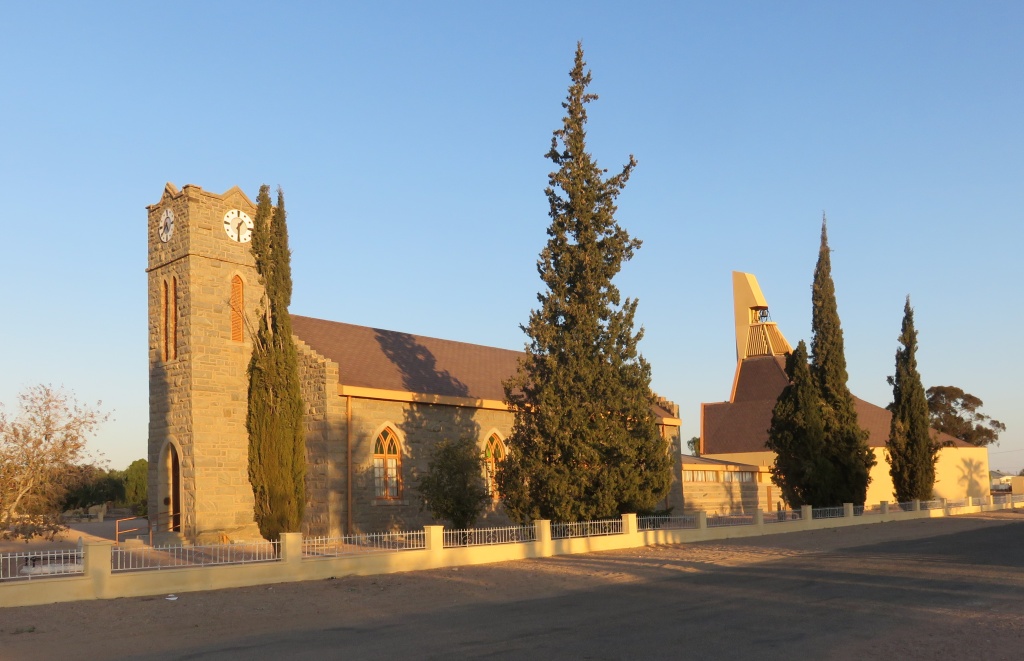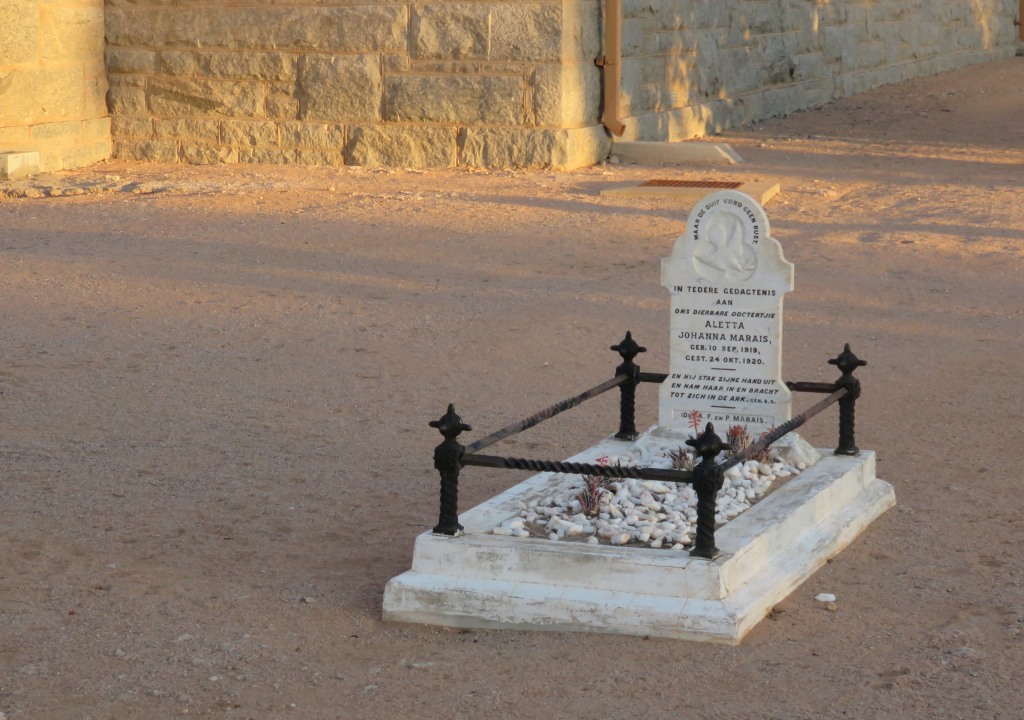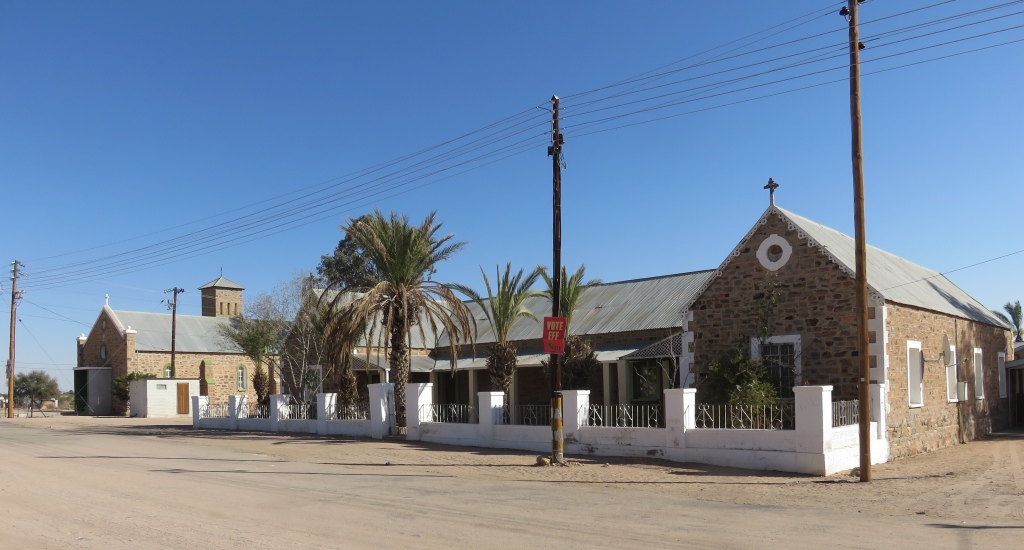
Pofadder
 Pofadder, one could say a town in the middle of nothing. Coming from Upington one passes through Keimoes and Kakamas and then 128km of nothing before you get to Pofadder. And on the other side 162km through desolate landscape before we get to Springbok. Position: 29.1253°S, 19.1253°E and 987 m altitude. It is a place of extremes, it can be very hot in summer, very cold in winter and in general also very dry with about 80mm rain fall a year. Certainly not a place where one would want to set up a lawn mower service center.
Pofadder, one could say a town in the middle of nothing. Coming from Upington one passes through Keimoes and Kakamas and then 128km of nothing before you get to Pofadder. And on the other side 162km through desolate landscape before we get to Springbok. Position: 29.1253°S, 19.1253°E and 987 m altitude. It is a place of extremes, it can be very hot in summer, very cold in winter and in general also very dry with about 80mm rain fall a year. Certainly not a place where one would want to set up a lawn mower service center.
History
The first European person to arrive in the area was Reverend Christian Schröder who set up a mission station in 1875. And named it after the Korana chief, Klaas Pofadder. Settlers arrived as from 1889, drawn by the perennial spring that used to be on the north side of the N14 where it passes through town. A town was established with the first plots being sold 1917. Its initial name was Theronville, named after the member of parliament T.P.Theron at the time. It looks like that name was never fully accepted and in 1936 it was officially changed back to Pofadder.
NG church
 The church, now a national monument, was built 1922. The sources (Ref 2) talks about first a hall (kerk saal) was build in 1921 and than the hall got a tower in 1922. The corner stone of the church states that the stone was laid on the 20 May 1922 by Ds J.A.v.z. Viljoen.
The church, now a national monument, was built 1922. The sources (Ref 2) talks about first a hall (kerk saal) was build in 1921 and than the hall got a tower in 1922. The corner stone of the church states that the stone was laid on the 20 May 1922 by Ds J.A.v.z. Viljoen.
 In the yard is a lone grave, that of Aletta Johanna Marais, born 10 Sept.1919, died 24 Oct.1920, she was a daughter of the minister at the time.
In the yard is a lone grave, that of Aletta Johanna Marais, born 10 Sept.1919, died 24 Oct.1920, she was a daughter of the minister at the time.
A new church was built in 1978, but built such that it is connected to the old church.
Roman Catholic church
 In 1919 Bishop Simon bought a property in Pofadder with the intention of starting a mission. The first building that went up was a convent, a structure using natural stones available in the area. This was housing a school and an orphanage. To sustain the mission they started, and are still doing it, to farm with poultry, large and small livestock.
In 1919 Bishop Simon bought a property in Pofadder with the intention of starting a mission. The first building that went up was a convent, a structure using natural stones available in the area. This was housing a school and an orphanage. To sustain the mission they started, and are still doing it, to farm with poultry, large and small livestock.
Later a church was built, see the building behind the convent. I have no information about when that happened.
People of Pofadder
Klaas Pofadder
The person the town is named after, Klaas Pofadder. Ref 1 states that the mission station was named after him in 1875. Other sources give the information that he was killed by irate farmers for theft of life stock, that appears in various other sources. It gets very confusing, what is the truth? What may be significant that in 1922 the NG congregation changed its name from Namie to Pofadder. Would they have adopted the name Pofadder if he was a life stock thief? And also note that the town eventually adopted the name.
His grave is believed to be on the north side of the national road passing through town. We didn't find it during our visit.
Gert Niemöller
One of the sources states:'Gertjie Niemöller is the only millionaire that Pofadder has produced, and probably ever will'. There we are, I just had to find out about his life and what he did to make himself a millionaire.
Gertjie was born in Pofadder and most of his money was made from mining siliminite and semi precious stones. What is silimanite? It is a mineral with the chemical formula Al2SiO5, aluminum silicate. Its main use is for refractories, these are the fireproof bricks used in furnaces, kilns, reactors. The other side of the mining business was that he collected semi precious stones and processed them for the jewelery trade.
In the 1950's he started to farm with Karakul sheep in Klein Pella, it later developed into a stud.
His real claim to fame is that he started the Date farm in Klein Pella. Later in life he called this his biggest folly, it sounds like he never made much of a profit from it. Now-a-days it is a thriving business, exporting most of the products. It is interesting to read how it started. He went to the USA in the 50th of last century where that type of Dates, the Medjools dates, were grown commercially, to collect shoots, 7000 of them. This he did in face of competition from Israel who actually had an agent permanently stationed in the country to collect every shoot they could find. Israel was at that time building up a Date industry. Of the 7000 shoots he brought into the country, 4000 survived and became fruit bearing trees. A set back knocked the farm when the Orange river came down in floods, covering the trees for some time. It killed a fair percentage of the trees.
Here was a man of many talents, and note he didn't need a degree in mining to start mining, he didn't need a degree in agriculture to start a Karakul stud and a Date plantation, it's all self taught. I personally admire people like that, they have made a difference, check my comments I made when writing about Sammy Marks.
Next time I go to that area I have to pay a visit to Klein Pella, we had run out of time.
And by-the-way, there is a family connection to the well known pastor Martin Niemöller in Germany. And I have a personal story to tell when I met the pastor many years ago, but not on this page, it would be out of place. I'll create a subpage which you can go to if you want to, just press Pastor Niemöller, it will take you there.
Reference:
Ref 1.: Standard Encyclopedia of Southern Africa, Nasou Limited, 1974
Ref 2.: 'Staan Op', booklet published by Lael Trust, 2010, available at Luise Niemöller shop in Pofadder<.br>
Ref 3.: 'Thirstland Epic - Heroic Struggle of Pioneer Missionaries in Namaqualand',Trans Orange Drukkers - Upington, 1996
Ref 4.: 'Leisure Wheels - The Adventure Motoring Magazine', issue no 98 June 2012